-
Paper Information
- Next Paper
- Previous Paper
- Paper Submission
-
Journal Information
- About This Journal
- Editorial Board
- Current Issue
- Archive
- Author Guidelines
- Contact Us
Architecture Research
p-ISSN: 2168-507X e-ISSN: 2168-5088
2012; 2(6): 122-127
doi: 10.5923/j.arch.20120206.02
Comparison of Iranian Mosques Architecture in Three Dynasties
Mohammad Jooshesh, Negar Kolahi
Undergraduate student of Architecture, Department of Architecture, Faculty of Art and Architecture, Mashhad Branch, Islamic Azad university, Mashhad, Iran
Correspondence to: Mohammad Jooshesh, Undergraduate student of Architecture, Department of Architecture, Faculty of Art and Architecture, Mashhad Branch, Islamic Azad university, Mashhad, Iran.
| Email: |  |
Copyright © 2012 Scientific & Academic Publishing. All Rights Reserved.
Present article tries to assess three Iranian mosques architecture during 1000- 1700 A.D. based on architecture styles and different kingdoms. According to this, Khorasani, Azeri and Isfahani styles were compared in Jameh, Goharshad and Sheikh Lotf Allah mosques.
Keywords: Iranian mosques, Isfahani style, Safavid period, Goharshad mosque, Jameh mosque
Cite this paper: Mohammad Jooshesh, Negar Kolahi, "Comparison of Iranian Mosques Architecture in Three Dynasties", Architecture Research, Vol. 2 No. 6, 2012, pp. 122-127. doi: 10.5923/j.arch.20120206.02.
Article Outline
1. Introduction
- Classical architecture, especially temple in general and mosque in particular is the image of the cosmos or man in his cosmic feature. The human body is the temple where spirit has settled in. Monotheistic view of tradition, not only comprises architecture and its entirety, but also includes every architectural element such as space, shape, color, light and matter. Since the unitarianism view which is stressed in Islam does not deem anything beyond its gamut and does not recognize the sphere of earthly wisdom, the entire Islamic architecture, whatever its employment, is perceived as an utter sacred architecture as mosque in its traditional position[1]. Iran's Islamic architecture is influenced by two major branches: What is outside the indigenous culture of Iran and What belongs to the indigenous culture of Iran before Islam. Application of arch, vault and dome on square base and veranda are derived from the Parthian (250-226 BC), Sassanid (224-652 BC) and Achaemenid period (559-321 BC.)[2]. With the commencement of Islam, Iranian architecture was influenced by China and the West piecemeal and subsequently new materials were replaced and emerged in the construction of mosques.[3]. Iranian Islamic architecture principles include: Human adaptation: It means having human scale, i.e. a room is contemplated in terms of human needs.Nyaresh: This term refers to things that sustain the structure. Including the static, building technology and materials science. Self-efficacy means providing the material from the nearest locations with the lowest price.Introspection, the existence of the outdoor courtyard in the center of the structure[4]
2. Aesthetic Elements of Islamic Architecture in Iran
- Light is the main characteristic of Iranian architecture, a symbol of divine wisdom and the manifestation of God that finds expression in his home which is the mosque. It also has an prominent role in reducing the rigidity and frigidity of stone and structure. As a result, sleek, polished tiles on floors and sometimes mirror work in ceiling are utilized to bring forth a beautiful reflection of light. Color is attained through light amplification and it represents a plurality which has innate connection with unity. White is the symbol of absolute being, sacredness, purity and tranquility which can be observed in the interior design of the mosque. Azure portrays the area within and the immensity of the sky, turquoise is the symbol of sanctity and yellow as the brightest color depicts brightness and light which are a symbol of insight and comprehending. Green with the combination of yellow and blue, is a sign of peace and hope and it is a mixture of science and faith. Black which is fortifying, covers Caaba and it is the primary symbol of God. Water is the foundation of life that cleanses filth. Water in the mosque is not only used for cleansing of eremites but also it reduces the rigidity of the structure. Water discoloration summons man toward discoloration and unpretentiousness, and its fluidness accentuates the frailty of the edifices that human-beings construct for their eternity. A different application of water in mosque is to reflect the image of the building in itself which creates a mirror for the observer.[5]. The mosque is a place for worship and prayer. Man is striving to migrate to the spiritual city and reach from ignorance to lore and through traveling this way his spirit will be discovered and the flesh is the means of this move. Accordingly, he has made places where he can unite the soul and body. Including, Iranian mosques which while creating a visual pleasure, induce a journey in spirituality to man. Mosques predominantly follow a fairly similar pattern and include common elements such as bedchamber, dome, cloister, courtyard, portico and the altar which are constructed in the direction of Qiblah (Caaba) in Mecca. The altar is analogized to rainbow and the arched portico is analogized to mountain which reflect nature. Different parts of mosques are following: Lighthouse or minarets with the meaning of focus of light, is one component of the mosque which were made in the past as a guide for pedestrians lost in the desert and awakening of the sleeping souls. However, the minaret is an expression of divine guidance and direction. Dome With the regular division, the basis of which is a circle and is an image of an infinite whole, to regular polygons, one can discern smaller stars resembling polygons. The concept of dividing the circle into equal arcs is a symbol of unity and plurality to achieve unity. i.e all creations in the world with the plurality at the same time are an indication of the Almighty. Since the dome overlooks the sky, tree of heaven (Tuba), is the best to decorate the interior surface. Using inverted tree indicates the world image in a mirror and is a symbol of heaven. The dome is usually built on a square or polygon and Iranian domes are conical , joined and discrete. Pool in the mosque, is located in the center of the courtyard which has flowing water. The pool is the mirror of water, image of the sky and seven color tiles. Thus, this is the mirror that makes possible the visit of the sky and the earth. Myansra or apron: which is the central courtyard features Islamic architecture and it is considered to be the resting place for travelers and a cleansing spot that is usually rectangular, square or polygonal. Apron is the access point to the bedchamber. The cloister, which has been popular since the Parthian period, consists of a vault and is opened and closed to apron from three sides. This element has input and output spaces which prevents sunshine and causes the airflow and it is decorated by Muqarnas and brickwork, stucco and tile work . Cloister is referred to the columned indoors existing around the apron. The columned bedchambers have low height and are located around the dome. The altar which is usually located on the south side wall of the mosque with regards to the direction of qiblah is hollow or sunken into a part of the wall. Most mosques were made in the city center, close to markets and the city hall vicinity and provided the city needed more mosques, they were built by the government or philanthropists. The mosque was of major significance that if there were no mosques in a town, that town would be considered trivial. The plan structure of the mosque was mainly single porch, double porch and four porch and a combinations of four arches and porch which was derived from the architecture of Parthian and Sasanid period.
3. Results
- The study focuses on the comparison of the architecture of three mosques in three reigns, which are built in three different styles - Jāmeh Mosque of Isfahān, Khorasani style, Seljukid period. This dynasty was founded in the eleventh century by the Ghaz Turks who came to Iran and Minor Asia in order to occupy the fertile lands of Transoxania. Art flourish in this period was owed to the political peace of that period and one of the significant art works of Seljukid period is the Jāmeh Mosque of Isfahān. Jameh mosque of Isfahan or Friday mosque, would be considered as the oldest historic monument. The present façade of the building mostly relates to the Seljukid dynasty, however, the upkeep and expansions refers to later period, especially that of Safavids. Archeological excavations, however, shows signs of the previous kingdoms before Seljukid, such as Al-E-Buyeh and the third A.H. Pre-Islamic signs were spotted in these excavations.There are a variety of entrances to the building, each of which relates an area to the surrounding environment; the entrances have not been built at the same time though they were designed in difference times in relation to the inside and outside the building. The crossways around the mosque proves the significant relation between the mosque with the ancient part of the city. Jameh Mosque of Isfahan has been built on a four-cloister basis; based on various references and due to the collection of artistic and architectural innovations of the 13 Islamic centuries, it is proven that the building was damaged and rebuilt due to conflagration and multiple wars, in addition to the unrests in different periods. The mosque has been built in Khorasani style, following pillared bedchamber plan while the plan has changed to the four-cloister in Razi style. The four cloisters around the square clarify the Persian style of mosque construction which has affected other mosques as well. The cloisters which are named Sofeh Saheb in the South, Sofeh Darvish in the North, Sofeh Ostad in the West and Sofeh Shagerd in the East of the building with muqarnas and adornments, elucidate one of the interesting techniques of Persian architecture. None of these four cloisters contain a completely blocked rib while the open rib of the cloisters is toward the apron of the mosque; the walls of the other three ribs lead to the bedchambers and surrounding salons. The internal surface of the mosque, the minaret and tiles are related to the 15 A.D which are likely related to the same period. The present main building of the mosque includes following parts: The bedchamber of the mosque (Shabestan) which is anchored on circular pillars, adorned with extremely beautiful cornices and relates to Dailamis period.Nezam-ol-molk dome and its forty pillars around it which have been placed in the second cloister of the mosque and built in between the years 1044 to 1064 A.D.; the dome was built in the reign of Malek Shah Seljukid and consultation of Khajeh Nezam-ol-Molk and is of scarce examples of Seljukid kingdom. The front cloister of this brick dome has been built at 12 century and its roof is mixed with large muqarnas . The dome was adorned with the most beautiful patterns of brick and plaster. The aperture of the southern dome is 15 meters.
 | Figure 1. Jame Isfahan mosque |
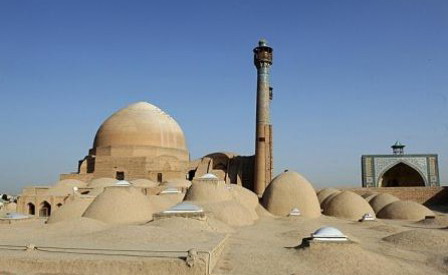 | Figure 2. Nezam-ol-molk dome |
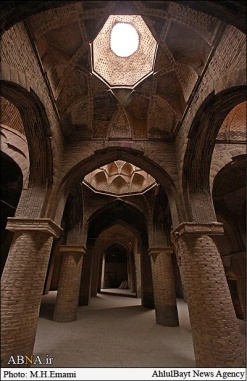 | Figure 3. The columned bedchambers |
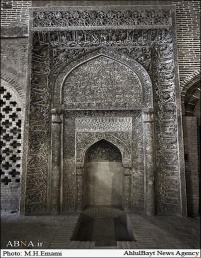 | Figure 4. Oljaito altar |
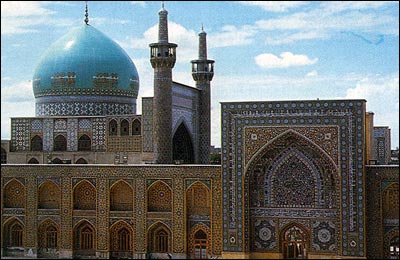 | Figure 5. Goharshad mosque |
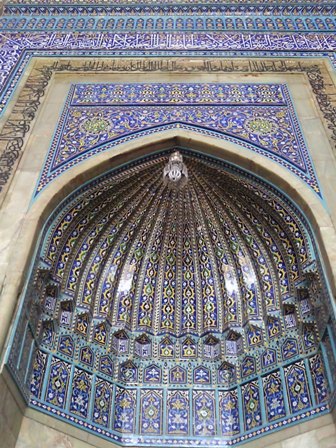 | Figure 6. seven colors tiles in ornamentation |
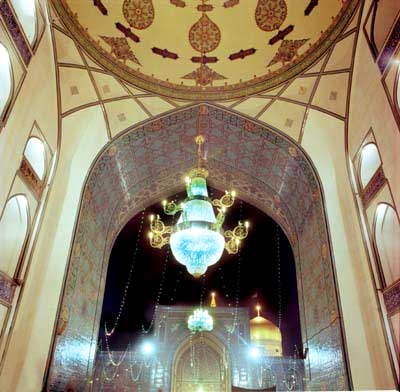 | Figure 7. Maqsoureh cloister |
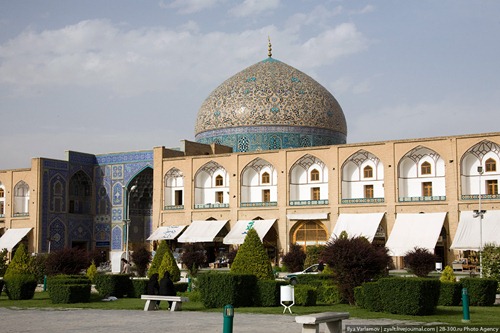 | Figure 8. Sheikh Lotf Allah mosque with cream dome |
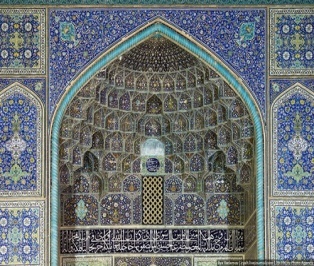 | Figure 9. Interior ornamentation |
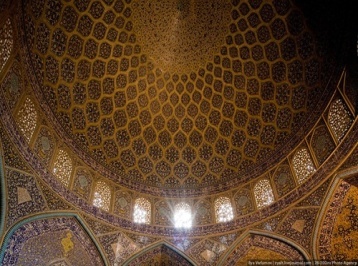 | Figure 10. Interior ceiling ornamentation |
4. Discussion
- Above mentioned mosques have three different styles. We could see a tend from simple to complex structure. For example, in Jameh Isfahan mosque, Khorasani style is observed with rectangular plan, bedchamber space or 40 columns, simple and without ornamentation of the bare bricks and decorative bricks and mud sometimes use a single minaret in the north building, elliptical arcs, egg width. Goharshad mosque has been built based on Azeri style with construction of large buildings, according to the vertical proportions, making the The porch with rectangular plan, diversity in the the porch, the use of decorations, such as plaster, tile and tile embossed gold, making the throat or shoot. Finally, Sheikh Lotf Allah mosque has been built as Isfahani style. It is identified with rectangular plan or a simple polygon, high quality materials and durable porch plans, the use of tile seven colors[10],[11].
5. Conclusions
- With regard to the architecture of mosques in Iran, it can be noted that in general architecture of pre-Islam has been very influential in the construction of mosques in Iran. The implementation of minaret, dome and the porch which are related to the Achaemenid, Parthian and Sasanid confirms this issue. In fact, the utilization of these buildings in mosques was aligned with the goal of building mosque which is the same as prayer, solitude and deep meditation of self and the creation. In mosques, the strive is to create tranquility, silence and attention to God which is characterized in its water, color and lighting. In Islam, flowers and plants and birds were only to be inserted , for no prophet is portrayable and God cannot be perceived and mosque is the place for the manifestation of the visage of God which plants and birds are a symbol of God. As it is comprehended regarding the Kingdom periods, Selijukid period mosques resemble those of Arabs and lack ornamentation and tile work. Decoration was done on brick and Muqarnas and they were normally single-minaret. In the Timurid period huge buildings construction was a show of strength which resulted in the construction of big mosques. Tiling with seven special colors and stemmed domes are the features of this period. In the Safavid period mosques we can observe the apex of ornamentation and tiling, mosque has become a special art work which for a Muslim establishes spiritual state and brings visual joy as well, and for a tourist, miracle of drawings and beautiful graphic is displayed at the mosque.
 Abstract
Abstract Reference
Reference Full-Text PDF
Full-Text PDF Full-Text HTML
Full-Text HTML